“Joker: Folie À Deux” Cinematographer Lawrence Sher Dissects 3 Essential Scenes
“The movie is an extension and a further exploration of this idea of our shadow selves as human beings,” Joker: Folie À Deux cinematographer Lawrence Sher tells The Credits. “We all have sides of ourselves that we hide from people. There are also sides we show to people that aren’t really authentic, and that’s what this movie explores.”
Sher, who was nominated with an Academy Award for Todd Phillips’ Joker, returns to collab with the director on a visceral sequel that sees the Crown Prince (Joaquin Phoenix) fall madly in love with Lee Quinzel (Lady Gaga) who gets him in more ways than he could have ever imagined. Music and sound pulsate a story that blurs the line between fantasy and reality as Arthur faces the legal consequences of nonchalantly killing late-night host Murray Franklin (Robert De Niro) under the bright lights of live TV. While the original film was an exploration of a deeply troubled character, Joker: Folie À Deux has Arthur questioning who he really wants to be: Arthur Fleck or Joker…or both.
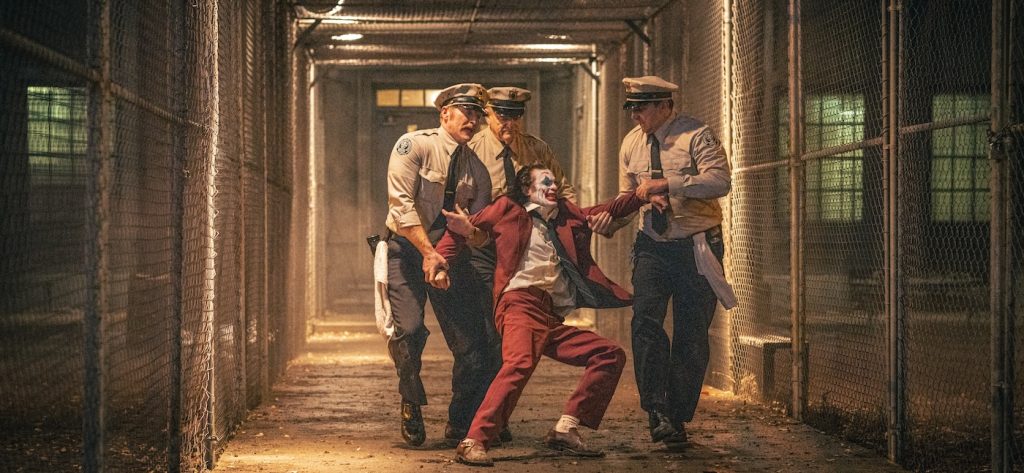
In photographing the proactive imagery, Sher looked to large-format storytelling, pairing the ARRI Alexa 65 with Nikon, Canon, Leica, Hasselblad, and Arri lenses to evoke visually specific emotions and feelings. For instance, a Nikon 58mm was used primarily for emotionally expressive moments with Arthur. Over the 75-day shooting schedule, nine of them were split between New Jersey and New York to film exteriors at a courthouse located at 60 Centre Street and to return to the now infamous Joker stairs in the Bronx, where production hired local kids from the neighborhood to help on set. Time in New Jersey was spent at the shuttered Essex County Isolation Hospital in Belleville, which stood in for Arkham Asylum. The remaining days were filmed at 8 different stages on the Warner Bros. lot in Los Angeles, which gave creative freedom to the actors and crew in a more controlled environment. What it meant for production designer Mark Friedberg was building sets that supported the free-range approach.
“We don’t really plan out specific shots in advance,” notes Sher. “So what we are really doing is settling in an environment in which we can basically shoot as close to 360 degrees as possible and then discover it in real-time with the actors. So, with each take, we’re trying something different and discovering frames and feelings of what Joaquin or Lady Gaga are doing. So we make adjustments based on them.”
Below, Sher dissects three of the most important visual ideas in Joker: Folie À Deux. Spoilers below.
THE INTERVIEW
Years after the events in Joker, Arthur Fleck is being held at Arkham State Psychiatric Hospital. Comatose from a daily dose of drugs, his frail body shuffles the halls as if a stiff breeze could knock him over. His lawyer, Maryanne Stewart (Catherine Keener), is his only lifeline to potential criminal freedom. Her defense: Arthur has a “split personality.” A step in publically shaping that narrative is an interview between Arthur and high-profile news anchor Paddy Meyers (Steve Coogan). The scene becomes a pillar to reveal who Arthur truly is.
We started everything from the reality of what it would be down to the set build. Todd referenced the famous Tom Snyder interview with Charles Mason, so we started from there and asked what was interesting about it. They did those interviews in a very special way, so that’s what Paddy is doing here with Arthur. He’s putting him in an actual cell with bars behind him and closing the door.
From a practical standpoint, the two cameras that are shooting the interview are live cameras. They would be photographed, so my gaffer, Rafi Sanchez, and I talked about what the units should be because they had to look at the era. We found these Ikegami bodies, which we tested, but instead of shooting with them because we wanted more control over the image, we created a LUT to mimic them. And because we wanted to send a live feed [of the interview cameras] to the monitors that are in the room where Maryanne [Keneer] is watching, we cut the Ikegami bodies in half and hid a RED Komodo inside. One is being operated by our A camera operator Colin Anderson; the other is operated by Home Alone cinematographer Julio Macat because we wanted someone who looks the part.
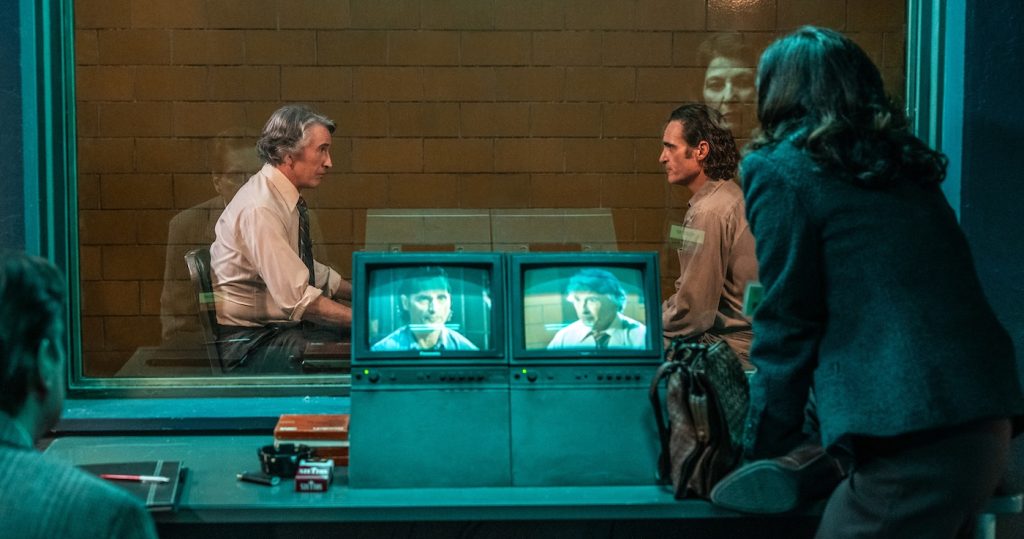
How did you want to photograph the moment Arthur confronts Paddy about not wanting to know the real him?
Because it’s a set, we were able to take out a section of the wall that you don’t see, and that’s where the B camera is, which I was operating for the scene. It’s on a small crane, and the camera starts with these eye-level shots. If you remember, at the beginning of the movie, when Arthur is being interviewed by a social worker, she asks what he remembers about the night with Murray Franklin. Arthur basically parodies what the woman said, like he’s trying to play the part and be a good soldier, which is what Maryanne wants until he breaks.
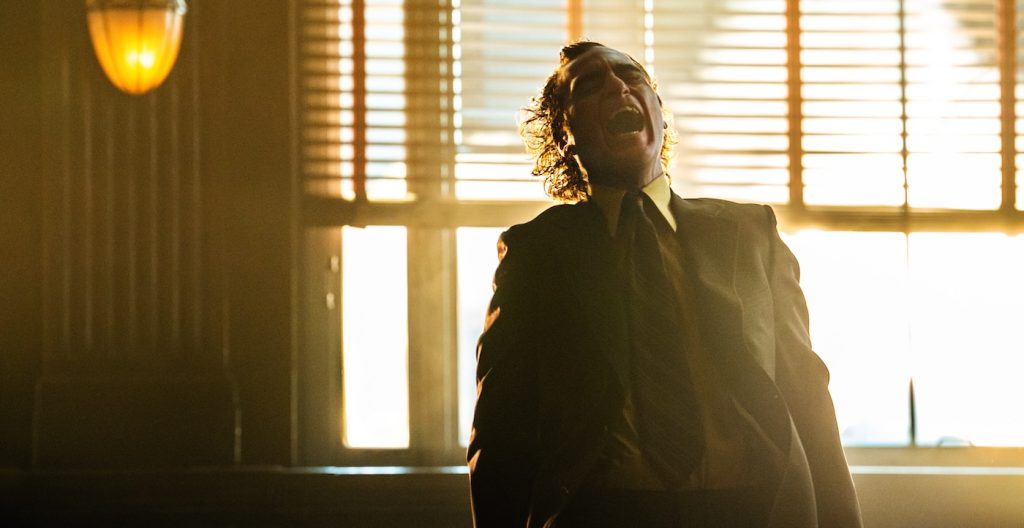
And when Arthur is like, ‘You don’t want to know the truth,’ we go with this powerful low angle, with different lensing than the rest of the shots, to break us out into what is basically an Arthur/Joker struggle. It’s on a Nikon 58mm, which became our workhorse Arthur lens, our intimacy lens. And when he starts singing, we now have a camera with fluidity, which is a big part of it. So we are breaking out of this sort of traditional coverage at eye level into something much more intimate and off-axis.
LIVING IN A FANTASY
Arthur discovers himself through song and music, which is explored on-screen through fantasies, including one on a rooftop, inside the courtroom, and at a wedding chapel. The sequences shape the story of his inner self, and to pull them off, collaboration among camera, sound, choreography, and the actors is required to make them transcendent yet immersive.
Everything about them was very much intentional. Even the way in which we enter the fantasies, the color, where the light is coming from, the production design—everything wants to be as if we are not photographing it but just capturing it as if we walked into a real place.
When he sings “The Joker,” which happens in the courtroom, he’s exploring his shadow self, so what better way to do that than to start in more dramatic shades of all that, including color? The silhouette is the most dramatic separation of shadow and light. First of all, it’s a violent scene. We are already questioning if Harley is good for Joker or is Harley good for Arthur. She’s a potential danger. There’s also the danger and the threat that is at the scene, so that’s why it’s in the same courtroom. But all the lighting is now this underexposed red light as the base with spotlights that expose Joker and Harley within that courtroom. There’s no other lighting on anybody else in the room. It’s just on them, so inherently, it’s about darkness. It’s about danger and threat with the red and violence. And it’s this exploration of their shadow sides of themselves. It’s meant to be a little bit scary.
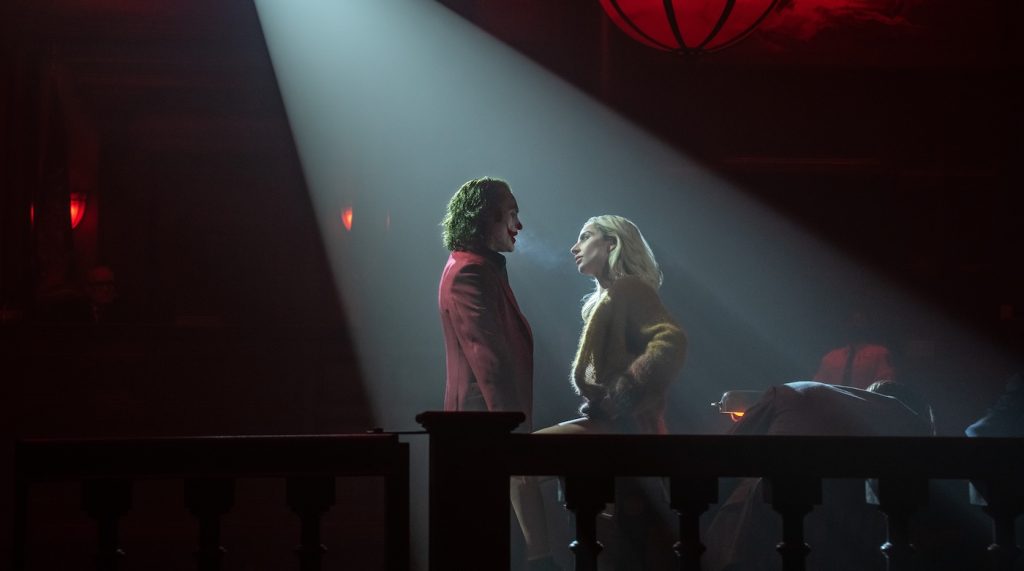
A similar silhouette theme appears when Arthur and Harley dance on a rooftop as Lady Gaga sings the song “Folie à Deux.”
Yes, the first thing lit on the rooftop is the big moon, which also reveals the shadow silhouette of Harley doing her metamorphosis. And then we reveal Joker coming out of the blue together. They join once they start dancing together. That’s the warmth of their love. So then the color goes warm, and by the end, it goes sort of green.
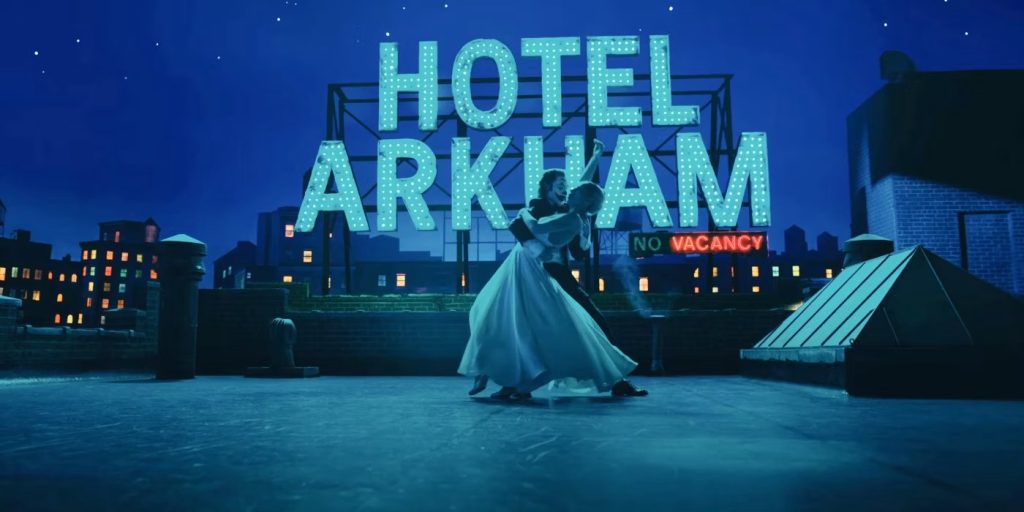
Juxtaposing the fantasy inside the courtroom is the wedding chapel sequence leading to the song “Gonna Build A Mountain.” What went into your approach?
When we finally get to the chapel where they get married, it is joy and love. We start in this silhouette in the same way we expose where we are slowly through lighting changes. One is a black void with Harley in a white wedding dress, and the other is Arthur in a white suit in a black void. Then, we show the path to join them. She has to walk through this curved walkway that’s lit up and meant to be almost black and white. Then, when the chapel comes on screen in black and white, this beautiful sunset background reveals the warmest light of the whole movie when they kiss. This scene is where they’re actually in the most joyful state in the whole movie.
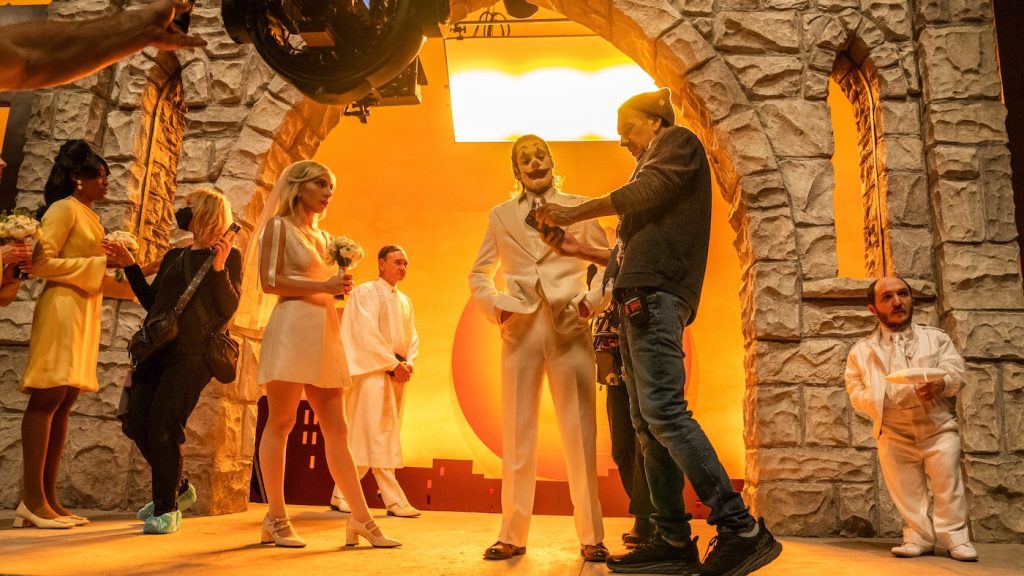
REVEALING THE JOKER
When the case against Arthur turns unfavorable, he fires his attorney and chooses to defend himself… as the Joker. This dramatic turn highlights Arthur’s struggle to find his place between reality and fantasy.
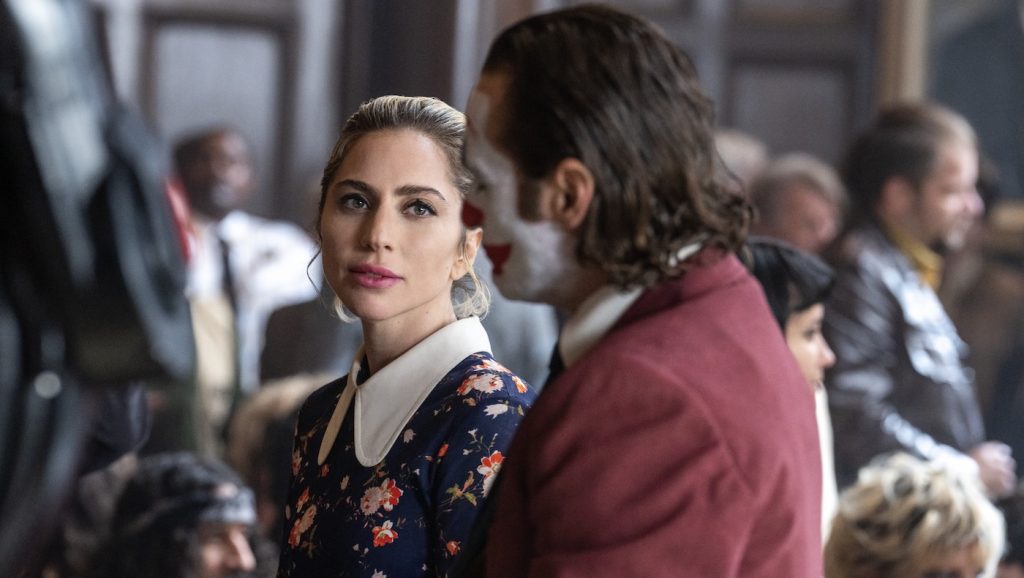
It’s like he now has the freedom, right? There’s a little camera move when he first reveals himself as Joker. That may be the only time we use Steadicam to give it a little different feel. It has its own inertia, and it’s different from the precision of the crane or dolly, where we can move quite slowly and really precisely.
When he interrogates Gary [Leigh Gill], that’s all Steadicam to give us that full fluidity and full 360 degrees. The set is lit so that Joker can go anywhere, and we actually circle him to create a sense of energy. However, that circling is also a little disorienting because his interrogation of Gary doesn’t go great. It’s a bit of a mess. So the idea is to represent with the camera that he’s searching for ideas that don’t go anywhere. He’s trying to evoke power, but he’s stumbling. Then, when he’s basically in his closing statement, that’s handheld, which we don’t do a lot in the courtroom, so that’s a new piece of language for that part of the courtroom.
Joker: Folie À Deux is in theaters now.
For more on Joker: Folie À Deux, check out these stories:
The Villain Returns to Venice as “Joker: Folie à Deux” Makes its World Premiere
New Joker: Folie à Deux” Teasers Unveil Gotham’s Killer New Crooners
Featured image: Caption: (L to r) JOAQUIN PHOENIX and director TODD PHILLIPS on the set of Warner Bros. Pictures’ “JOKER: FOLIE À DEUX,” a Warner Bros. Pictures release. Photo Credit: Niko Tavernise/™ & © DC Comics



